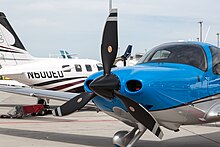Hartzell Propeller
 | |
| Industry | Aerospace |
|---|---|
| Founded | 1917 |
| Founder | Robert Hartzell |
| Headquarters | , |
Key people | Joe Brown (Chairman) |
| Products | Aircraft propellers |
| Divisions | |
Hartzell Propeller is an American manufacturer that was founded in 1917 by Robert N. Hartzell as the Hartzell Walnut Propeller Company.[1] It produces composite and aluminum propellers for certified, homebuilt, and ultralight aircraft. The company is headquartered in Piqua, Ohio.[2]
Hartzell also produces spinners, governors, ice protection systems, and other propeller controls.[2][3]
History[]


Robert Hartzell grew up in the village of Oakwood, Ohio, just a block from Hawthorn Hill, where Orville Wright lived.[4] From the 1890s until the late 1910s, Hartzell's father and grandfather operated a sawmill and lumber supply company in Greenville, Ohio (later moved to Piqua, Ohio) that also manufactured items like wagons and gun stocks for World War I.[5][6] On the side, Robert owned a small airplane and did maintenance on it as a young man. In 1917, Orville Wright suggested that Hartzell use his walnut trees to manufacture an aircraft propeller for his plane and others. As a result, Robert Hartzell founded the Hartzell Walnut Propeller Company in Piqua that same year, and the company provided "Liberty" aircraft propellers for World War I warplanes.[7][8]
After the war, Hartzell Propeller built its own airplanes, including the FC-1 (the first aircraft made entirely of plywood).[9] The FC-1 took first place in the Flying Club of St. Louis Trophy Race at the 1923 International Air Meet.[9] An alteration to the wings resulted in the improved FC-2 model, which won over aircraft from the Waco Aircraft Company and the Curtiss Aeroplane and Motor Company at the 1924 International Air Races in Dayton, Ohio. Hartzell stopped producing aircraft to avoid competing with its own propeller customers.[9] In 1926, Hartzell began building propellers for the Aeronca C-2.[10]
During World War II the company produced metal propellers for Hamilton-Standard. After the war, Hartzell produced the first composite propellers for the Republic RC-3 Seabee. Hartzell began making aluminum propellers in 1948 and developed the first full-feathering propellers for a light twin-engine aircraft in the 1950s. These were used in the Aero Commander, Piper Apache, Cessna 310, and Beech Twin Bonanza.[11]
Hartzell introduced a turboprop propeller in 1961 and, in 1975, certified a 5-bladed propeller for the Shorts 330.[9][12] In 1978, the company produced a composite aramid fiber propeller for the CASA 212.[13] In 1989, Hartzell produced sixteen-foot propellers for the Boeing Condor, another record-breaking aircraft.[11]
Hartzell introduced Top-Prop, replacement propellers for piston-engine aircraft, in 1991, and sold 20,000 Top-Prop conversion kits from 1991 to 2013.[14]
In 1994, the company held the first Friends of Hartzell Air Show in Piqua, Ohio.[15] for which Hartzell developed its first aerobatic system. In 2013, the Red Bull Air Race World Championship chose Hartzell to provide 3-blade composite propellers, carbon fiber composite spinners, and governors to race teams.[16] In 2006, the FAA granted Hartzell the first certification for an Advanced Structural Composite (ASC II) propeller for general aviation.[17]
In July 2021, Hartzell Propeller purchased the assets of Tanis Aircraft Products, a company that makes aircraft engine pre-heat systems. Tanis President and CEO Douglas Evink will become Hartzell Propeller's vice president of sales for the new Tanis business unit. The Tanis operations will remain near Anoka County Airport, outside Minneapolis, Minnesota.[18]
See also[]
References[]
- ^ Aerial Age: 4. 15 March 1920.
{{cite journal}}: Missing or empty|title=(help) - ^ a b Purdy, Don: AeroCrafter - Homebuilt Aircraft Sourcebook, page 84. BAI Communications. ISBN 0-9636409-4-1
- ^ Hartzell Propeller (2009). "Product Applications". Retrieved 8 February 2012.
- ^ W., Ronald, Bruce (1983). Oakwood : the Far Hills. Ronald, Virginia., Oakwood Historical Society. Dayton, Ohio: Reflections Press. ISBN 091342840X. OCLC 10430349.
- ^ Hartzell Air Movement (2012). "Annual Report". Archived from the original on 10 March 2014. Retrieved 17 January 2014.
- ^ Computerized Heritage Association (1999). "Memiors of the Miami Valley, George W. Hartzell". Archived from the original on 3 February 2014. Retrieved 17 January 2014.
- ^ The Cincinnati Enquirer (2003). "Hartzell Propeller Still Building on Historic Past". Retrieved 17 January 2014.
- ^ WoodenPropeller.com (2005). "Early WWI Era Propellers". Retrieved 17 January 2014.
- ^ a b c d Keisel, Ken: Dayton Aviation: The Wright Brothers to McCook Field, page 126. Arcadia Publishing. ISBN 9780738593890
- ^ The Aeronca Museum (1930). "Archive Database Record Details". Retrieved 17 January 2014.
- ^ a b Janet R. Daly Bednarek, Michael H. Bednarek: Dreams of Flight: General Aviation in the United States, page 142-143. Texas A&M University Press. ISBN 1585442577
- ^ Conklin & de Decker Aviation Information (1930). "Aircraftpedia". Retrieved 21 January 2014.
- ^ NotPlaneJane.com (1930). "Hartzell/Hartzite". Retrieved 21 January 2014.
- ^ General Aviation News (29 July 2013). "Hartzell Top Prop 20,000 Ready to Take to the Air". Retrieved 22 January 2014.
- ^ Hartzell Propeller. "A Long History of Innovation". Retrieved 22 January 2014.
- ^ General Aviation News (13 November 2013). "Red Bull Taps Hartzell for Race Plane Props". Retrieved January 22, 2014.
- ^ Aero News Network (24 July 2006). "Hartzell Intro's ASC-II Composite Prop". Retrieved 22 January 2014.
- ^ Phelps, Mark (13 July 2021). "Hartzell Propeller Acquires Tanis Aircraft Products Assets". AVweb. Archived from the original on 14 July 2021. Retrieved 15 July 2021.
External links[]
| Wikimedia Commons has media related to Hartzell Propeller. |
- Aerospace companies of the United States
- Aircraft propeller manufacturers
- Manufacturing companies based in Ohio
- Manufacturing companies established in 1917